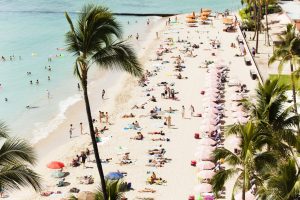The Quietest Hawaiian Island: Places To Explore
Hawaii is known for its beautiful beaches, expansive volcanoes, and lush green forests. What many people don’t know, however, is that there’s a quieter side to the Aloha State. In this blogpost we’ll discuss the criteria by which it is determined whether an island is quiet and which of the Hawaiian islands meet these conditions. We’ll also give you some tips on how and when to go there!

Conditions of Being Quiet
The conditions under which an island can be considered quiet include:
- distance from civilization
- population and tourists
- level of urbanization
- untouched nature
- safeness
Kauai: The Northernmost of Hawaiin Islands
If you’re looking for an escape from the crowds and the noise, head to Kauai – the northernmost of Hawaii’s main islands. The island can be quite serene when you get away from the resorts in Poipu and Hanalei Bay. Kauai is home to some of the most secluded and pristine beaches in the world, as well as rugged cliffs and valleys that are just begging to be explored.
A perfect example of this is Koke’e State Park through which the Alaka’i Swamp trail runs. It’s a good hike that spans across a few miles, and offers some of the best views in Kauai. Because this is a hike that’s meant more for nature lovers, it’s a less traveled path with significantly fewer tourists.
Head to Kauai in mid-December or early January for the best chance of catching a glimpse of the rare humpback whale! They swim from Alaska all the way to Hawaii just to give birth, nurse their calves, and mate. While you’re there, turn your gaze upwards to the night sky—you might just get a glimpse of the Northern Lights.
Lanai: The Least Inhabited Hawaiian Island
The smallest inhabited island travelers may visit in Hawaii, Lanai offers big enticements to its visitors. Only nine miles from Maui yet a world away, Lanai can feel like two places. One half is the relaxed, friendly home of just about 3,000 locals. The other half is vast expanses where nearly all signs of development are outside Lanai City. There are some luxury hotels but no chain restaurants or shops on this island (somehow).’
The island has some great beaches and some good hiking trails. Charter boats go snorkeling daily; the fantastic Hulopoe Beach on the east side can be crowded at times but it’s still a real treat for most visitors, if you want to swim with turtles or just have a nice beach for yourself.
Molokai: The Least Tourisic Hawaiian Island
Molokai, the most remote of the main Hawaiian Islands, is also the least visited and has the least touristy atmosphere. There are no stoplights or malls on Molokai, which keeps it rustic and quiet. Unlike Lanai, there aren’t many lodgings available and it’s the most difficult island to arrive at by air.
People who live there consider it to be the greatest place to reside. People leave their doors unlocked at night and there aren’t any dangerous animals here…just chickens! It is one of the most secluded Hawaiian Islands, with many long-standing families and few visitors, when compared to other islands in the chain. Thus, it isn’t as crowded as some other islands – Molokai is definitely a place to relax and unwind from life on the mainland.
Kahoolawe: The least Visited Hawaiian Island
Kahoolawe Hawaii is almost uninhabited island. After the first Polynesian explorers arrived around 500AD., Kahoolawe was used as an training ground for new warriors on Maui.
Until recently, Kahoolawe was used by the U.S. Navy for bombing practice throughout World War II and later during the Vietnam War era. It’s now managed by Hawaii State as a feral animal preserve and watershed, and the only people allowed to visit are biologists and environmentalists. No camping or overnight lodging is available on this quiet island, which averages just 70 visitors per month.
Niihau: Altimately Connected To The Native Hawaiian Culture
Niihau is extremely isolated; in fact, guests are only allowed on Niihau for a maximum of two weeks per year. As part of an old Hawaiian promise to preserve its culture, outsiders (including Hawaiians) are not permitted to visit without an invitation from one of the 70 Native Hawaiian residents living living on its 114 square-mile landmass. They are intimately connected to their natural environment, with food sources including fish, wild boar, taro root, sweet potatoes and more. The native Hawaiian culture on Niihau is kept alive by traditional hula dancers practicing every night on full moons.
All shipments are subject to approval by the island’s residents, who are committed to keeping outsiders out. If you find yourself with an invitation to visit this mysterious land of few people, make sure your sunscreen is packed!
In Conclusions
We hope you enjoyed learning about the quiet side of Hawaii. If you’re looking to get away from the hustle and bustle of everyday life, any of these islands would be a great choice. Mahalo for reading!